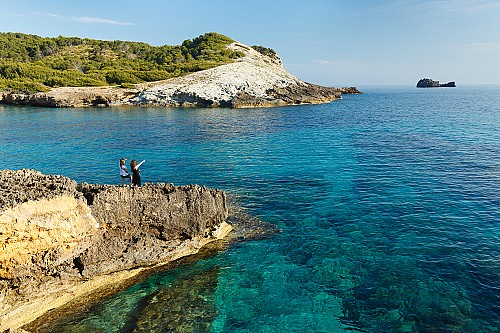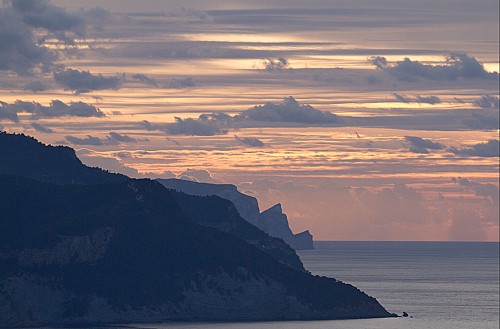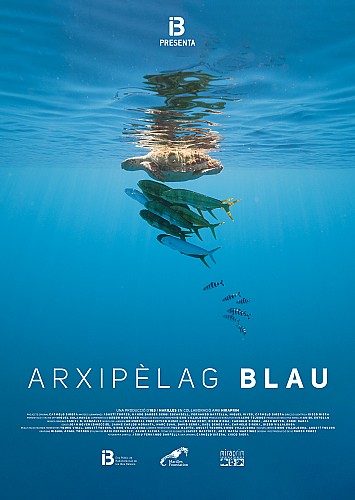10 EUR of benefit for every euro invested in the MPA of Llevant (Mallorca)
Published 23.07.2021
Share

10 EUR of benefit for every euro invested in the Marine Protected Area of Llevant (Mallorca)
Madrid and Palma, 24 July, 2021.Investing in Marine Protected Areas (MPAs) pays off. This is the conclusion of an investigation into the benefits of Mediterranean marine reserves for the economy and wider society, commissioned by the Marilles Foundation and developed in collaboration with Ecoacsa, the Balearic Center for Applied Biology (CBBA) and the British consultancy Eftec.
- The study reveals that for every euro invested annually in the MPA of Llevant generates 10 euros of benefit.
- This is the first time that a natural capital accounting methodology is applied to a Spanish marine protected area.
- A methodological guide has been published together with the investigation, to facilitate the application of natural capital accounting to other marine protected areas.
- The investigation has been conducted within the framework of the European Interreg Med MPA Networks.
The Fisheries Marine Reserve of Llevant in Eastern Mallorca (Balearic Islands) covers 11,000 hectares, of which 5,900 hectares are under autonomous jurisdiction and 5,100 are under state jurisdiction. It was established in 2007 at the request of the fishermen’s association of Cala Rajada to improve catch and economic performance of the small-scale fleet, but results suggest that benefits go far beyond fisheries-related benefits:
- The natural capital from the Marine Protected Area of Llevant is contributing EUR 4,826,518 per year to the local economy, equivalent to EUR 75 per hectare annually. The present value of future benefits within a horizon of 60 years exceeds EUR 126 million.
- The annual investment required to maintain the natural capital of the reserve is EUR 473,137.
- Services related to recreational activities represent the largest share of the benefits, with 65% of the total (EUR 3,141,340), followed by regulation services such us prevention of coastal erosion (EUR 772,547, 16%) and maintenance of biodiversity (EUR 447,313, 9%).
- Although the 7.4 tons of fish landed by the professional fishing fleet have a small economic value (EUR 129,646) in comparison to the overall benefits, the MPA has helped maintain key jobs in a sector which has been declining over the past decades. This value has not been included in the final estimate.
Aniol Esteban, Director of Marilles Foundation: “The results of this study show that MPAs provide multiple economic benefits. Investing in them pays off. The paradox is that marine protected areas of the Balearic Islands and in the rest of Spain are massively underfunded. Although the fisheries marine reserve of Llevant is giving positive results, we must not forget that it is still far from reaching its potential. Ensuring a proper level of funding we provide even higher returns on investment. The same applies to most marine protected areas in the Balearic Islands and Spain. The health of our sea and our coasts is essential for the economic prosperity of the Balearic Islands and Spain. As a signatory of the EU Biodiversity strategy Spain has committed to declaring at least 30% of the marine area as MPA by 2030 and at least 10% of the marine area under strict protection. Establishing a solid and well-funded network of marine protected areas must be a key part of the economic recovery in Spain. Having more and better marine protected areas will bring large benefits for two strategic industries such as tourism and fishing. We can come out of the post-Covid crisis by improving the state of our coast and our sea.”
David Álvarez, Executive Director of Ecoacsa: “Natural Capital Accounting provides evidence of the relationship between a marine protected area and the real economy. It is a specially useful tool to assess changes of marine areas and oceanic ecosystems over time. It offers essential data to support decision-making that results in the greater and better protection of the wealth and health of marine ecosystems, which is vital to combat biodiversity loss crisis and guarantee the provision of the necessary services that sustain blue growth, in support of the Green Deal and the European Union Recovery Plan for Europe. There will be no green growth without blue growth.”
Benjamí Reviriego, environmental consultant of CBBA: “Natural Capital Accounting is a key tool about the benefits derived from sustainable natural resources protection and management, and for integrating biodiversity into economic and policy decision-making guaranteeing that natural capital continues to provide ecosystem services to society. Its usefulness, however, strictly depends upon input data availability and particulars, whose achievement represents considerable efforts”.
ANNEXES
Natural Capital Accounting
Natural capital accounting is a practical framework that can help public and private actors make better decisions through a better understanding of the interaction between the economy and the environment. Specifically, it provides a systematized process to measure and report the stocks and flow of natural capital, considering both biotic resources (habitats and species) and abiotic (water, soil, atmosphere, minerals ...) and the flow of benefits that these generate (services ecosystems). The premise of natural capital accounting is that the environment is essential for society and the economy, so it has to be considered as a valuable asset that must be properly maintained and managed, and the ecosystem services that it provides are properly integrated into the national accounts systems.
To build the natural capital accounting system, Ecoacsa has relied on the Corporate Natural Capital Accounting developed for the United Kingdom Natural Capital Committee, which are aligned with the System of Environmental Economic Accounting of the United Nations (SEEA EEA, for its acronym in English), recently approved on a global scale.
The application of this accounting framework has provided knowledge and the ability to account for the economic value of the biodiversity and marine ecosystems of the Llevant MPA, as well as the relationship between these, the economy and the well-being of the residents who live and work in the area, along with the tourists who visit its coasts and enjoy its sea. This is essential in providing rigorous information that facilitates decisions, aligned with local needs and broader commitments in terms of sustainability, to the various actors with responsibility for the management of protected areas.
Marine protected areas in the Balearic Islands and Spain and the 30/10 target for 2030
As part of the EU Biodiversity Strategy, Spain has committed to declaring a minimum of 30% of its marine surface as a marine protected area by 2030 and a minimum of 10% of its marine surface under strict protection.
The Balearic Islands have a network of marine protected areas that cover up to 21.5% of the Balearic Sea. In inland waters (those under the jurisdiction of the Balearic Government) this percentage increases to 40%. It is a high percentage compared to other areas of Spain, Europe or the Mediterranean. However, only 0.16% of the Balearic Sea - 45 km2 equivalent to half of the island of Formentera - is an integral reserve and is closed to fishing. And only a part of the area declared as MPA has a management plan.
Even so, the Balearic Islands are one of the most advanced Spanish regions in terms of marine conservation. Most of the Balearic marine reserves are giving good results in the form of a greater biomass, an increase in the size and diversity of fish of commercial interest and an improvement in the status of vulnerable species and habitats, with all the economic benefits that this entails. However, the vast majority of MPAs in the Balearic Islands and the rest of Spain perform below their potential because they lack the necessary means to guarantee good management, monitoring and surveillance. A study by the Marilles Foundation carried out in 2019 calculated the annual investment in the MPAs of the Balearic Islands at about 3 million / year; and that although the number of marine protected area has increased notably in recent years, the expenditure per protected hectare has decreased in comparison. The growth rate of protected marine surface in the Balearic Islands during the last 40 years has been 135 times higher than that of integral reserves (no-take zone).
Sources:
https://marilles.org/storage/media/2020/06/579/es-briefing-amp-maig20.pdf
https://marilles.org/storage/media/2020/09/660/es-informe-seguimiento-de-peces.pdf
Guide for applying natural capital accounting to other marine protected areas
To facilitate the replication of similar studies, a methodological guide has been developed for the application of natural capital accounting in marine protected areas. The document aims at serving as guidance to representatives of public or private entities - local, regional or national administrations, universities, research organizations, NGOs, economic and social actors - involved in the management of MPAs so that they contribute to consolidating a sustainable management of marine natural capital. Thus, the guide offers a detailed description of the steps to be followed in order to analyze and evaluate the extent, condition, quantity and current value over a 60-year horizon of the natural resources of the Llevant AMP, including the valuation methods used for each type of ecosystem service analyzed, results obtained and lessons learned.
Source:
MPA Networks Project - EU Interreg
Marilles participates as a partner in the European project Interreg Med MPA NETWORKS (marine protected areas working in a network), which seeks to improve the effectiveness of Mediterranean MPAs by proposing solutions in four fields: effective management, management of small-scale fisheries, conservation of mobile species and sustainable financing. All are in line with Marilles' strategic priorities.
The project - 85% funded by the Interreg MED program - is coordinated by MedPAN and brings together ten Mediterranean partners, mainly MPA management bodies from seven countries: Albania, Croatia, France, Greece, Italy, Slovenia and Spain.
Marilles' job is to export the experience of projects on MPAs in the Balearic Islands and in other regions of Spain, at the same time that it will import examples to other parts of the Mediterranean that may be of interest.
ABOUT
Marilles Foundation is a non-profit entity that works to make the Balearic Islands a world example of marine conservation. It finances local projects and organizations to improve the sea and the Balearic coast. It is open to contributions from other foundations and individual donors.
Between 2018 and 2020 Marilles has invested EUR 2 million in 49 marine conservation projects in the Balearic Islands; which probably makes it the first source of private financing based in Spain for the conservation of the marine environment at the national level. Among others, Marilles has catalyzed collaborative initiatives such as the Mar Balear Report (www.informemarbalear.org); the MARE audiovisual contest (www.marebalear.org) and has established a strategic collaboration with Observadores del Mar (www.observadoresdelmar.es) to consolidate the marine citizen science program in the Balearic Islands.
Ecoacsa Reserva de Biodiversidad is a Spanish company created with the aim of disseminating, promoting and developing tools that allow natural capital valuation and biodiversity integration into business sector. Ecoacsa provides market analysis and strategic advice to incorporate environmental sustainability and natural capital conservation in decision-making, action plans and strategies at corporate and project levels. Its focus is on promoting and facilitating the transition from “business as usual” towards sustainable business models.
Ecoacsa promotes the Natural Capital Factory, the Spanish regional hub of the Capitals Coalition, a global collaboration that transforms the way decisions are made by including the value provided by nature, people, and society.
The Balearic Centre for Applied Biology is a Spanish company created in 1994, which offers consulting, auditing, advisory, management and analysis services in the fields of the environment, food safety and quality control.
Since its creation, it has carried out evaluation studies of the repercussions of human activities on the environment, studies on marine and terrestrial ecosystems, coastal dynamics, dispersion and dilution in the marine environment, plans for environmental monitoring of works and projects; elaboration of thematic cartographies, bathymetric studies. It develops monitoring studies in marine protected areas, in coastal water bodies, and has led several R&D projects in the field of applied biology.
DOCUMENTS
PHOTO GALLERY
https://drive.google.com/drive/folders/1Rt7JznXOp3_t7UieaaUKuNmOV4mEiu_Y?usp=sharing





